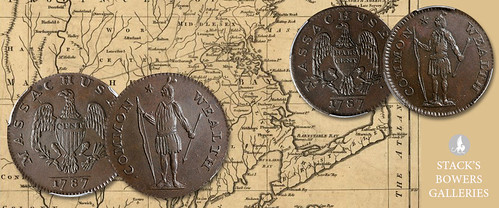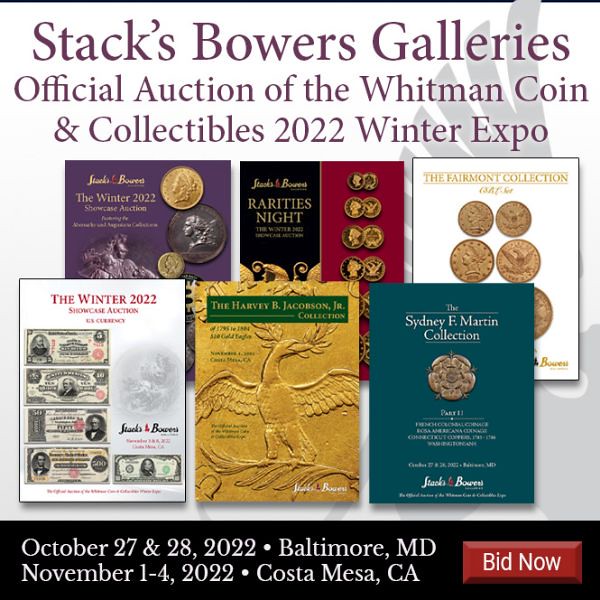
PREV ARTICLE
NEXT ARTICLE
FULL ISSUE
PREV FULL ISSUE
V25 2022 INDEX E-SYLUM ARCHIVE FIRST AMERICAN COIN WITH THE WORD "CENT"Another Stack's Bowers blog article, this one by Chris Bulfinch, discusses the first American coin with the word "cent" in its design. -Editor
The casual substitution of After the Revolution, the newly independent states grappled with the financial fallout from the conflict, producing coinage as a circulating medium of exchange and an expression of sovereignty. The second Massachusetts mint was unusual among post-Revolution state minting efforts, in that it was a public enterprise, authorized by the state legislature on October 16, 1786. In its short life it struck copper coins denominated half cent and cent in accordance with a 1785 Federal resolution decimalizing the Spanish milled dollar.
The half cents and cents share a design, with a standing Native American holding a bow in one hand and an arrow in the other on the obverse, a motif derived from the State Seal. A heraldic eagle with wings spread, clutching an olive branch and a cluster of arrows, appears above the date on the reverse, encircled by
These coins are, according to many numismatist historians, the first coins struck in the United States to bear the denomination Two notable engravers, Joseph Callender and Jacob Perkins, worked on Massachusetts cents and half cents. Callender was based on State Street, the same street where Stack's Bowers Galleries just opened a new gallery. The coins were not, in the late 1780s, economical to produce. When production stopped in January 1789, their face value was eclipsed by production costs. An audit found that the copper coins' cumulative face value was less than half of the expense to produce them. Their cost notwithstanding, the coins spent decades in circulation and were fairly popular. Counterfeit Massachusetts cents and half cents were produced, of lighter weights than the authorized coinage, likely at Machin's Mills. Interestingly, examples of counterfeit 1787 Massachusetts cents were used as planchets for 1788 Connecticut coppers, as they were comparable in weight to the official Connecticut issues. The Massachusetts legislature officially closed the mint on Nov. 17, 1788, but operations continued until the facility ran out of copper and it fully shuttered on January 23, 1789. The Constitution went into effect later that year, ending any further state coinage and closing an important chapter in early American numismatic history. We're offering an example of each Massachusetts denomination in our Winter 2022 Showcase Auction in lot 3117 and lot 3118. Here's the 1787 Massachusetts Cent, with a great provenance: Ex Wayte Raymond's sale of the Ellsworth Collection, April 1923, lot number not recorded; Hillyer C. Ryder; F.C.C. Boyd; John J. Ford, Jr.; our (Stack's) sale of the John J. Ford, Jr. Collection, Part V, October 2004, lot 95. Stack's lot tag, Ryder ticket, Boyd envelope and additional collector envelope with attribution and provenance notes included. -Editor
To read the complete article, see:
To read the complete lot descriptions, see:
With perfect timing for the Halloween holiday, here's how serious numismatists celebrate. Found in the Fall 2022 issue of The C4 Newsletter from the Colonial Coin Collectors Club. Thanks to Editor Will Nipper for providing the photo and caption for publication here. Happy Halloween! -Editor
Scene from Halloween 2021: Ron Swinnich of Westford, MA after carving a jack-o-lantern of a 1787 Massachusetts cent.
If based on a real coin, Mass. copper expert Mike Packard would assign this
For more information on the Colonial Coin Collectors Club (C4), see:
Wayne Homren, Editor The Numismatic Bibliomania Society is a non-profit organization promoting numismatic literature. See our web site at coinbooks.org. To submit items for publication in The E-Sylum, write to the Editor at this address: whomren@gmail.com To subscribe go to: https://my.binhost.com/lists/listinfo/esylum All Rights Reserved. NBS Home Page Contact the NBS webmaster 
|




